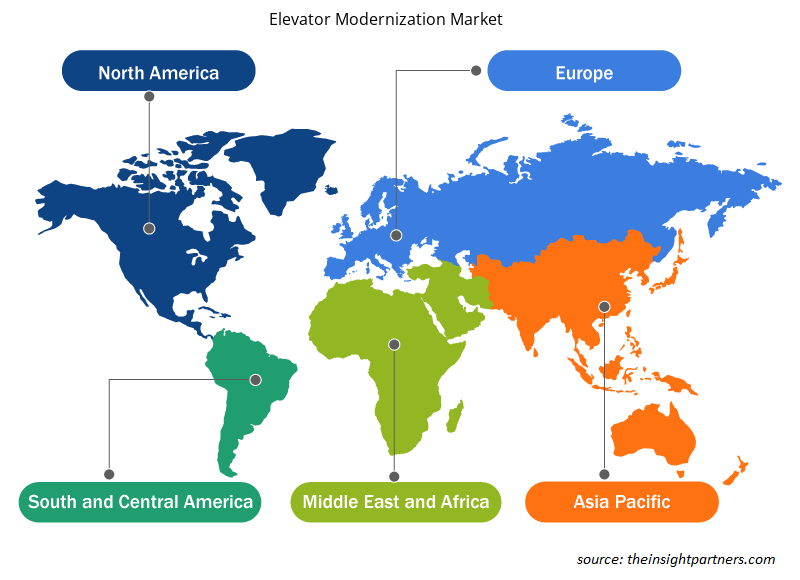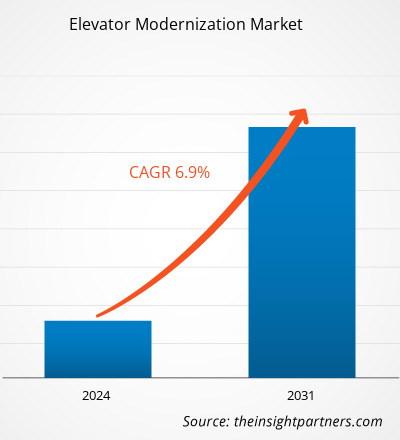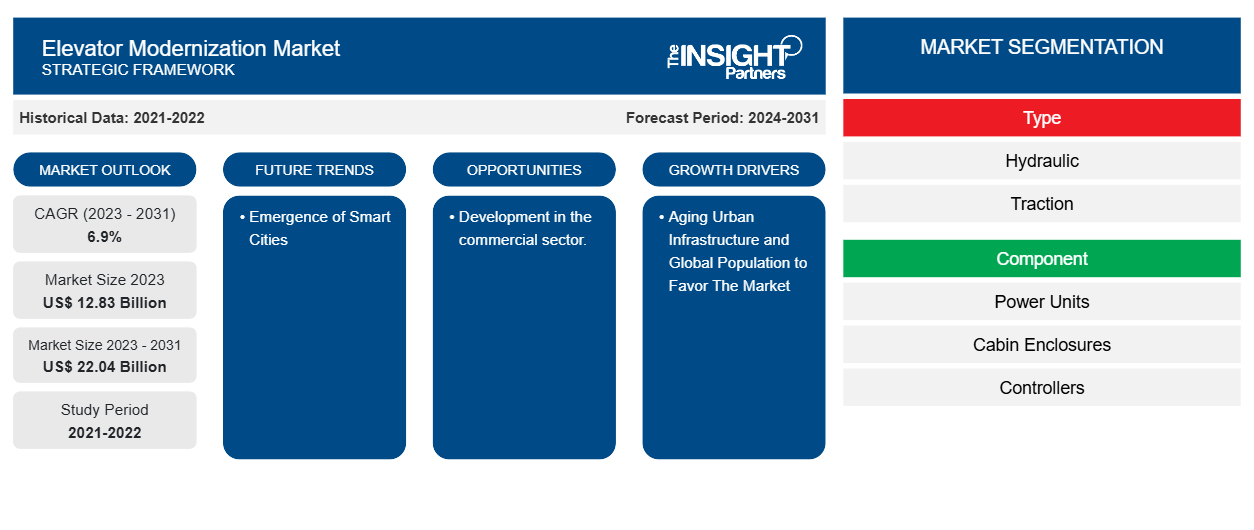电梯现代化市场规模预计将从 2023 年的 128.3 亿美元增至 2031 年的 220.4 亿美元。预计 2023-2031 年市场复合 年增长率为 6.9%。城市基础设施老化和全球人口增长是电梯现代化市场的主要趋势。
电梯现代化市场分析
电梯现代化市场正在快速增长。随着城市化的发展,消费者对住房和基础设施的需求也在增长。此外,人们发现商店、办公室、商场和其他公共区域使用的传统和现有垂直交通系统无法满足当前的容量。因此,人们不得不在公共和商业设施入口处排队等候更长时间。如今,在这个快节奏的世界里,没有人喜欢等待,因为这会浪费他们的钱。因此,电梯的采用是由电梯现代化推动的,而电梯现代化的推动源于对更无缝、更有效、更快速的垂直交通系统的需求。
电梯现代化市场概况
更新关键电梯部件的过程称为电梯现代化。电梯系统由许多不同的部件组成,这些部件最终会磨损,需要更新才能继续以最佳效率、安全性和性能运行。此外,升级还可以提高电梯的质量和美观度。
定制此报告以满足您的需求
您可以免费定制任何报告,包括本报告的部分内容、国家级分析、Excel 数据包,以及为初创企业和大学提供优惠和折扣
-
获取此报告的关键市场趋势。这个免费样品将包括数据分析,从市场趋势到估计和预测。
电梯现代化市场驱动因素和机遇
城市基础设施老化和全球人口有利于市场
根据预测,到 2050 年,老年人的比例将增加到全球人口的 22%。由于人口结构的变化,建筑物无障碍设施的必要性也随之增加。由于这些发展,城市规划师、建筑师和政府在建筑无障碍设施和城市基础设施方面面临困难。此外,时代已经发生了变化,因为老一代选择住在设施较少的地方,过着更偏远的生活方式。这将推动电梯现代化市场的发展。
商业领域的发展。
商业领域的发展可以通过增加对更新技术和服务的需求来为现代化市场创造机会。例如,随着企业扩张或采用新流程,他们通常需要现代化的基础设施、软件解决方案或自动化工具来保持竞争力。这种需求可以推动现代化市场的创新和投资,为专门升级和优化商业系统的公司提供机会。电梯现代化市场报告细分分析
有助于得出电梯现代化市场分析的关键部分是类型、组件和最终用户。
- 根据类型,电梯现代化市场分为液压和牵引。预计液压部分将在预测期内增长。
- 根据组件,市场分为动力装置、机舱外壳、控制器、信号装置、门设备等。动力装置部分预计在预测期内将有所增长。
- 根据最终用户,电梯现代化市场分为工业、住宅建筑、机构、船舶、商业和其他。工业领域预计在预测期内将实现增长。
电梯现代化市场份额按地区分析
电梯现代化市场报告的地理范围主要分为五个区域:北美、亚太地区、欧洲、中东和非洲以及南美/南美和中美。北美主导着电梯现代化市场。北美地区各行业的高科技采用趋势推动了电梯现代化市场的增长。由于新技术的引入和安全问题的增加,预计美国未来几年将大幅增长。由于住宅、商业和工业应用的增加,预计整个预测期内市场将大幅增长。甚至制造商也更加专注于提供配备最新技术进步的产品。所有这些因素都促进了该地区电梯现代化市场的增长。
电梯现代化市场区域洞察
Insight Partners 的分析师已详细解释了预测期内影响电梯现代化市场的区域趋势和因素。本节还讨论了北美、欧洲、亚太地区、中东和非洲以及南美和中美洲的电梯现代化市场细分和地理位置。

- 获取电梯现代化市场的区域具体数据
电梯现代化市场报告范围
| 报告属性 | 细节 |
|---|---|
| 2023 年的市场规模 | 128.3亿美元 |
| 2031 年市场规模 | 220.4 亿美元 |
| 全球复合年增长率(2023 - 2031) | 6.9% |
| 史料 | 2021-2022 |
| 预测期 | 2024-2031 |
| 涵盖的领域 |
按类型
|
| 覆盖地区和国家 |
北美
|
| 市场领导者和主要公司简介 |
|
电梯现代化市场参与者密度:了解其对业务动态的影响
电梯现代化市场正在快速增长,这得益于最终用户需求的不断增长,这些需求源于消费者偏好的不断变化、技术进步以及对产品优势的认识不断提高等因素。随着需求的增加,企业正在扩大其产品范围,进行创新以满足消费者的需求,并利用新兴趋势,从而进一步推动市场增长。
市场参与者密度是指在特定市场或行业内运营的企业或公司的分布情况。它表明在给定市场空间中,相对于其规模或总市场价值,有多少竞争对手(市场参与者)存在。
在电梯现代化市场运营的主要公司有:
- 通力公司
- 联合电梯公司
- 西门子
- 迅达
- 三菱电机美国公司
- TK电梯
免责声明:上面列出的公司没有按照任何特定顺序排列。

- 了解电梯现代化市场顶级关键参与者概况
电梯现代化市场新闻和最新发展
电梯现代化市场通过收集一手和二手研究后的定性和定量数据进行评估,其中包括重要的公司出版物、协会数据和数据库。以下是市场发展情况的列表:
- 2024 年 1 月,奥的斯巴西公司完成了圣保罗标志性 Birmann 21 大楼 13 部电梯的技术和美学现代化改造,按计划完成了为期 36 个月的现代化改造项目。奥的斯巴西公司是奥的斯全球公司的一部分,该公司是电梯和自动扶梯制造、安装和维护领域的全球领导者。
(来源:奥的斯,新闻稿,2023 年)
- 2022年3月,区块链技术与智能云服务提供商之一淘平科技宣布,公司与深圳市智汇云梯物联网有限公司签订战略合作协议(“协议”),共同应对电梯现代化和维保的市场需求。
(来源:淘屏公司,新闻稿,2022 年)
电梯现代化市场报告覆盖范围和交付成果
“电梯现代化市场规模和预测(2021-2031 年)”报告对以下领域进行了详细的市场分析:
- 范围内所有主要细分市场的全球、区域和国家层面的市场规模和预测
- 市场动态,如驱动因素、限制因素和关键机遇
- 未来主要趋势
- 详细的 PEST/波特五力分析和 SWOT 分析
- 全球和区域市场分析涵盖关键市场趋势、主要参与者、法规和最新市场发展
- 行业格局和竞争分析,涵盖市场集中度、热点图分析、知名参与者和最新发展
- 详细的公司简介
- 历史分析(2 年)、基准年、预测(7 年)及复合年增长率
- PEST和SWOT分析
- 市场规模、价值/数量 - 全球、区域、国家
- 行业和竞争格局
- Excel 数据集
近期报告
客户评价
购买理由
- 明智的决策
- 了解市场动态
- 竞争分析
- 客户洞察
- 市场预测
- 风险规避
- 战略规划
- 投资论证
- 识别新兴市场
- 优化营销策略
- 提升运营效率
- 顺应监管趋势























 获取免费样品 - 电梯现代化市场
获取免费样品 - 电梯现代化市场